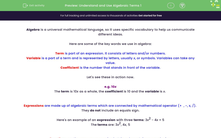Algebra is a universal mathematical language, so it uses specific vocabulary to help us communicate different ideas.
Here are some of the key words we use in algebra:
Term is part of an expression. It consists of letters and/or numbers.
Variable is a part of a term and is represented by letters, usually x, or symbols. Variables can take any value.
Coefficient is the number that stands in front of the variable.
Let's see these in action now.
e.g. 10x
The term is 10x as a whole, the coefficient is 10 and the variable is x.
Expressions are made up of algebraic terms which are connected by mathematical operator (+ , -, x, /).
They do not include an equals sign.
Here's an example of an expression with three terms: 3x2 - 4x + 5
The terms are: 3x2, 4x, 5
3x2−4y+2
Equations are the same as expression but they do contain an equals sign.
As a result of this, we can solve them for some, but not all, values of x (or another variable).
This is an equation: 5x + 9 = 24
And so is this: x2 + 3x - 12 = 0
Formula is related to an equation.
Formulae will also have an equals sign, but they will be true for many values of the variable.
Therefore, we cannot solve a formula, unless we know the values of some of the variables.
You might have seen some formulae in maths or science already.
Some well-known examples include:
Formula for speed: s = d ÷ t
Formula for area of a circle: A = πr2
To use these formulae, you need to know the value of one (or more of the variables).
Finally, have you come across the word 'identity' in algebra? It is simply an equation that is always true, no matter what values are substituted in for the variables.
2y + 3y = 5y is an identity because 2y + 3y will always equal 5y! Identities can also be written using this sign ≡, so we could write it as 2y + 3y ≡ 5y
In this activity, we will identify where these definitions apply and, therefore, which calculations we can and cannot perform in each situation.








